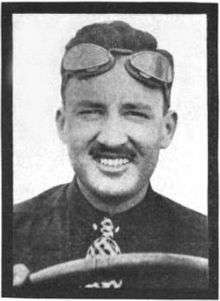Billy Carlson
Billy Carlson (17 October 1889 San Diego, California – 4 July 1915 Tacoma, Washington) was an American racecar driver. He was killed in an AAA National Championship race at Tacoma Speedway.[1]
| William "Billy" Carlson | |
|---|---|
 | |
| Nationality | American |
| Born | October 17, 1889 San Diego, California |
| Died | July 4, 1915 (aged 25) Tacoma, Washington |
| Years active | 1914-1915 |
| Teams | Maxwell |
| Championships | 0 |
| Wins | 0 |
Biography
Billy Carlson began his career competing in races on the Pacific coast and was a comparative unknown before he started in the 500-mile classic at Indianapolis in 1914. He took ninth in the event and "immediately attained prominence on the gasoline circuit."[1]
He was a member of the Maxwell team for two years in 1914 and 1915 after he was "discovered" by Ray Harroun, a Maxwell engineer. His most notable achievement after joining Maxwell was his world's non-stop record of 305 miles made at San Diego, California, in January 1915. He came in second to Barney Oldfield at Venice, California.[1]
Carlson sustained fatal injuries in the Montamarathon race at Tacoma Speedway on July 4, 1915.[2] Maxwell suspended their racing game for the remainder of the season and the team was disbanded and the automobiles were shipped back to the factory in Detroit.[1]
Indy 500 results
|
| ||||||||||||||||||||||||||||||||||||||||||||||||||
References
- Motor age, Volume 28, No. 2. The Trade Press Co., Chicago, Illinois - July 1915.
- "Auto Driver Dies. Billy Carlson Victim of Accident at Tacoma Speedway Races" (PDF). The New York Times. July 6, 1915. Retrieved 20 July 2012.